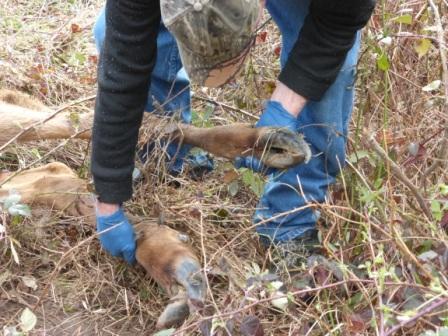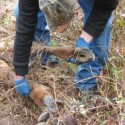I wish my family was getting ready to go elk hunting. I wish we were shopping for supplies, setting up our camp along the Coweeman River, and maybe even doing some scouting on the weekends.
Instead, my dad, my uncle, my brother and the rest of our hunting party are boycotting our Department of Fish and Wildlife and Weyerhaeuser for the fourth consecutive year.
It all began when a pitifully unsuccessful black powder rifle season prompted my family to start attending meetings and asking tough questions about why there were so few healthy elk. What we learned about elk hoof disease was sad, but what we’ve learned about the collusion between certain government agencies and the timber and chemical industries has been truly disturbing.
Read the column in The Chronicle

The more my family pried, the more we came to suspect that forest chemicals such as herbicides, adjuvants and fertilizers are either the primary cause or a chief contributing factor underlying elk hoof disease. At the very least, it seemed like a worthy hypothesis to study, and so we were surprised to learn that WDFW had never explored the connection, nor intended to. Rather, they have been content to pin the disease on bacteria that even their own technical advisers don’t believe to be the sole culprit.
As the unseemly ties between WDFW and the timber and chemical industries were revealed, it became clear to my family that WDFW’s integrity regarding elk hoof disease had been compromised. In one case, muckraking hunters helped prove that WDFW’s hand-picked herbicide “expert” was employed by a company that represents the manufacturer of Atrazine, an immunotoxic herbicide sprayed widely by local timber corporations even though it has been banned in many other countries for persistent groundwater contamination. Because of all this, my family was cautiously optimistic about the passage of Senate Bill 5474 earlier this year.
Unanimously approved by the state Legislature, SB 5474 was perceived by most observers as an official vote of no confidence in WDFW’s dismal researching efforts. Among other stipulations, the bill made Washington State University the new lead organization tasked with developing a program to “monitor and assess causes of and potential solutions for elk hoof disease.” Toward that end, the Legislature appropriated $1.52 million.
Unfortunately, my family’s optimism for WSU’s research is already sinking. Initial signals out of their College of Veterinary Medicine suggest that WSU intends to double-down on WDFW’s myopic and fruitless path of inquiry rather than include (at least, in part) a study of forest chemicals and related factors such as immunotoxicity, mineral deficiencies and water and soil degradation. This would be particularly frustrating considering that some of WSU’s own hoof disease technical advisers have agreed with the public that the investigation needs to have a wider environmental scope.
“(WDFW researchers) are mentioning lots of different bacteria. That’s one piece of the puzzle,” said Dale Moore, an expert in preventive veterinary medicine at WSU. “But there are other things that seem to be missing in the puzzle. Big pieces. The big pieces are the environmental factors and why this particular region and not other regions.”
As WSU researchers continue onward with their investigation, I hope they will remember that the funding for this special research was largely due to the tireless advocacy of citizens like Mark Smith and Bruce Barnes who are named in the SB 5474 documents. I also encourage WSU to understand that the people who live and work and recreate in the areas affected by elk hoof disease have been dealing with it for over a decade and are impatient to finally see their suspicions investigated with scientific rigor.
My family urges hunters, conservationists and concerned citizens to continue to pressure your local representatives and especially WSU’s College of Veterinary Medicine now that they lead the hoof disease investigation.
Let them know that you’re paying attention and that you expect some of your $1.52 million in taxes to go toward an honest and thorough study of the link between forest chemicals and elk hoof disease.
I may never get to pack another elk out of the woods with my dad or uncle, but if we stay devoted to rehabilitating our local herds, I’ll hopefully get to pack one out with my son or daughter someday.
My ongoing investigation of elk hoof disease and toxic forest practices is funded entirely by my readers. If you appreciate my work and believe that journalism should be fearlessly independent of corporate influence, then consider clicking on the donate button below so that I can continue giving these issues the time and attention they deserve. Thank you for your support.

Thank you for your effort to bring attention to this issue. It’s such a tragedy how the elk in SW Washington are suffering. I live in a heavily sprayed county in southern Oregon, Coos County, and am part of a group working to raise awareness of the toxicity of herbicides. Your writing has helped me reach some hunters in this area who wouldn’t normally question the timber industry.
I know you’re aware of this but I just read a summary of a study on CSU’s website (http://csu-cvmbs.colostate.edu/vdl/Pages/hoof-deformities-elk.aspx) stating that “Hepatic selenium and copper levels in all elk were severely deficient.” And we know copper and selenium and other minerals are needed for keratin formation, and we know glyphosate and other herbicides cause nutrient deficiencies. Somewhere else I read about the copper being super deficient in the elk, but they brushed it aside saying it’s only deficient compared to livestock and we just don’t know what is normal for elk. Such bull!
Anyway please keep up the fight. Evidence is mounting from so many areas about the dangers of herbicides and I think it’s only a matter of time before we see some real change. One county in Oregon, Lincoln, has passed an ordinance to ban aerial spraying (though they’re now being sued) and Lane County, OR is set to have it on the upcoming ballot.
Perhaps you have read some of the research by Mark Purdy in his investigation into Mad Cow, CWD and other prion protein diseases? Copper deficiency was demonstrated in his research to play a significant role in the Organophosphate model for these diseases. The fact that the scientist heading this WSU study is a prominent researcher in the CWD research community; that consistently overlooks this potential model for disease; gives me very little confidence in the investigation into elk hoof disease. .https://www.westonaprice.org/health-topics/farm-ranch/auburn-university-research-data-confirms-purdeys-environmental-research-data-on-tse/
There is a community of goat packers who would also have a great deal to say about the limitations of the research taking place at WSU. https://www.napga.org/2019/08/23/sierra-sequoia-nf-comment-period/
Please email me I have the answers you seek